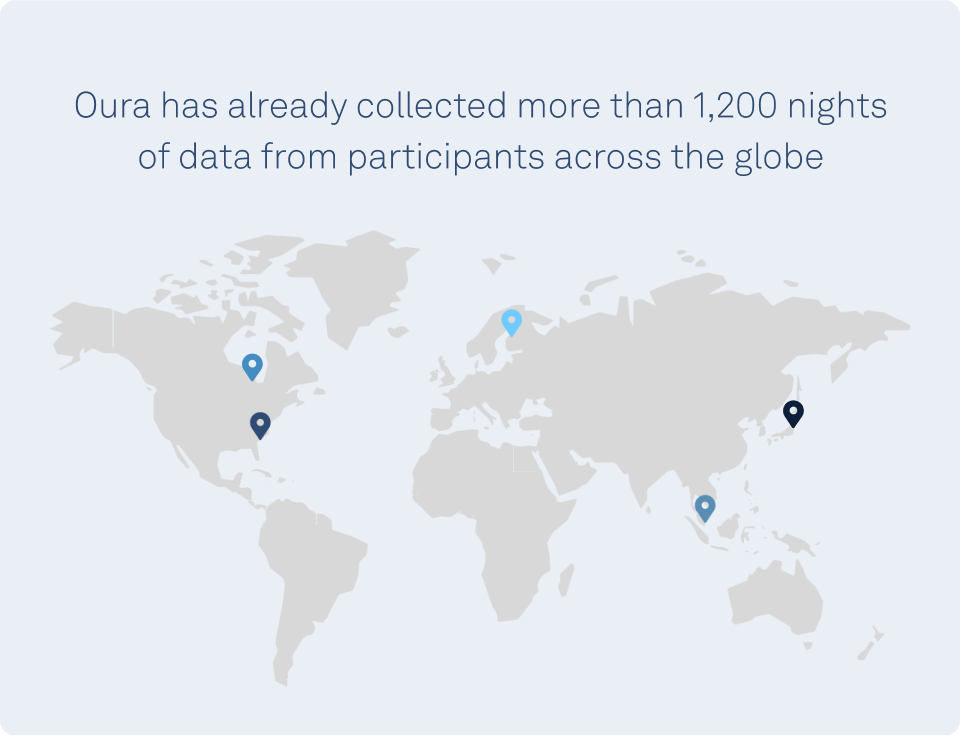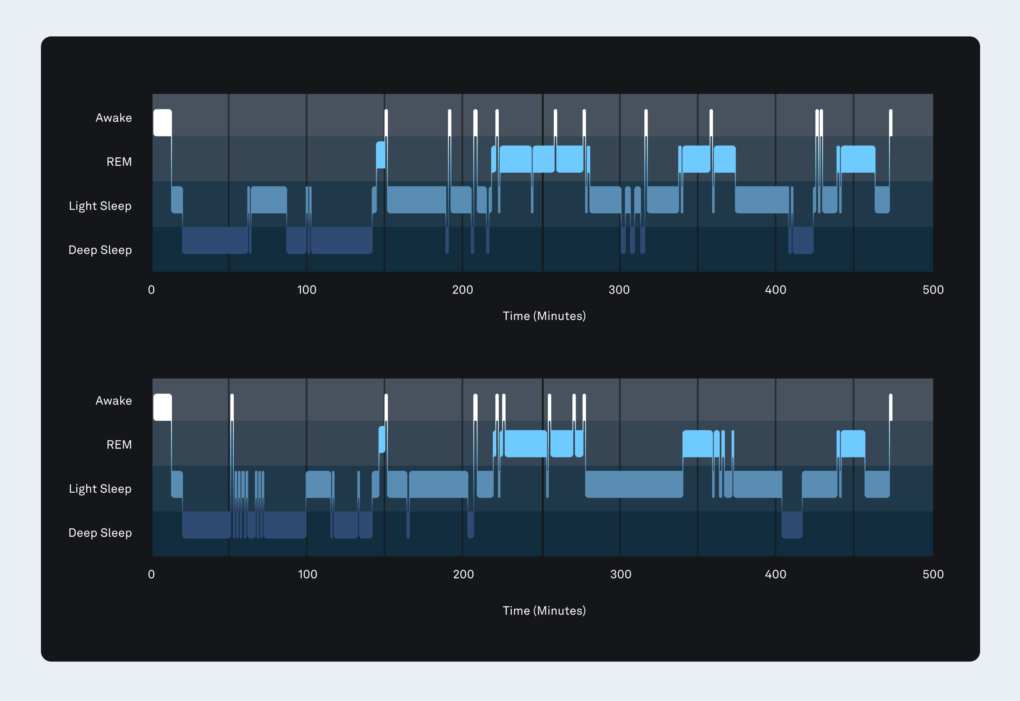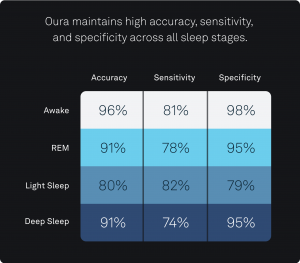At Oura, we’re committed to innovating and improving our health sensing algorithms through rigorous scientific processes, as well as sharing the research and validation with our community. Oura’s Sleep Staging Algorithm 2.0, which matches performance with the gold standard polysomnography (PSG) sleep lab test.
The result of more than two years of extensive research and development, this updated algorithm is based on a 2021 research study published in Sensors (a leading international, peer-reviewed, and open-access journal on the science and technology of sensors), which showcases the results of the algorithm.
How Accurately Does Oura Measure Sleep?
By leveraging every signal from the Oura Ring (movement, temperature, heart rate, and HRV), the Sensors study found Oura’s sleep staging algorithm achieves 79% agreement with gold-standard polysomnography (PSG) for classifying the four stages of sleep (wake, light, deep, and rapid eye movement (REM) sleep). By contrast, most commercial wrist-based wearables are limited to 60-65% agreement.
Oura’s new sleep staging algorithm was developed using advanced machine learning techniques and one of the largest wearable sleep datasets collected to date. This one-of-a-kind dataset includes diverse participants across multiple continents and sleep laboratories, demonstrating the power of using all of the signals of the Oura Ring to maximize accuracy.
Read the full paper in Sensors and see key takeaways below.
Additional Validation Studies
Since then, additional research has been conducted on Oura’s accuracy.
In 2024, a study conducted by the University of Tokyo further validated the accuracy of Oura Sleep Staging Algorithm 2.0. Comparing the accuracy of the sleep staging algorithm on Oura Ring Gen 3 to PSG, researchers found that Oura’s measurements “did not significantly differ” from PSG, bringing further scientific credibility to Oura’s sleep tracking ability. Read more about the key findings here.
In 2023, the National University of Singapore published a study that compared six wearable sleep trackers. They found that Oura has better agreement with PSG than four other wearables, including Fitbit Sense. The only device with better performance was the EEG-based Dreem headband; however, one third of the study participants did not tolerate the headband and had to remove it to sleep.
A Global Approach

One of the main limitations of current academic research and commercial products is that sleep staging algorithms are typically developed on a limited amount of data (typically 20-30 nights) and homogenous populations. Because these algorithms are “trained” on a narrow dataset, they may not perform the same when they’re extended to a broader, more diverse population.
To counteract that limitation, Oura has developed an even more accurate sleep staging algorithm by actively building one of the largest sleep datasets to-date.
The dataset already contains over 1,200 nights (and counting!) of simultaneous PSG and Oura Ring data from sleep labs all over the world. It’s already enabled Oura’s scientists to train and evaluate the algorithm across a diverse set of individuals. Notably, the database captures diverse sleeping patterns, including physiological responses, across several factors:
- Different environments (e.g. weather, climate)
- Different skin tones
- Different body compositions (BMI)
- Unique behavioral factors (e.g. eating habits that could influence sleep, or different wakeup times and bedtimes)
- A wide age range (15-73) to account for sleep staging changes that come with age (e.g., deep sleep decreases with age)
- People with and without sleep disorders
Using Every Metric
Most wearables use a combination of different body signals (e.g. heart rate, movement, etc.) to determine when you’ve fallen asleep and which sleep stage you’re currently in. Each sleep stage shows a distinctive pattern. For example, during deep sleep, your heart rate decreases, your respiration stabilizes (like a metronome), and your body’s temperature drops.
So, if you want to get a clear look at what’s happening on the inside after you’ve fallen asleep, the quality and accuracy of your sleep insights will depend upon your device’s ability to correctly measure and identify these distinct patterns.
Oura’s unique ability to leverage movement, temperature, heart rate, heart rate variability (HRV), and mathematical modeling that incorporates well known sleep patterns (e.g, REM sleep tends to occur later in the night) results in state-of-the-art sleep staging accuracy. The example below shows how closely Oura is able to match gold-standard PSG for a typical night.
LEARN MORE: How Does the Oura Ring Track My Sleep?
Below is an example hypnogram for a representative night of the validation dataset.

The top graph shows the sleep stages across the night determined with gold standard polysomnography. The bottom graph shows the sleep stages predicted by the Oura Ring algorithm (accuracy = 84%).
Read the full paper in Sensors for more insights on the relation between temperature, HRV, and different sleep stages.
Accuracy Across Sleep Stages
One of the main strengths of this algorithm is the high sensitivity and specificity it achieves across all sleep stages — ranging from 74% to 98%. While other studies have shown similar results for the detection of a specific sleep stage, this improved performance typically comes at the expense of the others (e.g. high performance in detecting deep sleep might result in a poor ability to detect REM).
This research demonstrates that a sophisticated model can maintain high sensitivity and specificity for all sleep stages.

Read the full paper in Sensors for additional box plots and graphs.
From the Oura Research Team
Lead author, Marco Altini, PhD, shares his excitement about sharing the new sleep staging algorithm with the Oura community:
“To develop the new sleep staging algorithm, we’ve collected a large dataset across the world, built key features relying on high-quality data from the sensors in the Oura Ring, and implemented a machine learning model outperforming current state of the art tools. For the first time, sleep staging using wearables not relying on EEG data, moved from 60-65% accuracy, up to about 80%. In the past few months, engineers and data scientists at Oura have taken our model and embedded it in the Oura Ring, so that every user can now benefit from the improved sleep stage detection accuracy. These are exciting times, as people will be able to better understand the impact of lifestyle and other factors on their sleep, while scientists worldwide will have an additional tool at their disposal to study sleep in real life settings, outside of the lab.”
In the meantime, we will continue to work directly with experts to advance sleep research and, of course, keep the Oura community updated each step of the way. Below, a note from Shyamal Patel, PhD, Head of Science at Oura:
“Our commitment to scientific validation and accuracy is exemplified in Oura’s research and development approach for the new sleep staging algorithm. This algorithm represents a significant leap in sleep tracking with consumer wearables and a major milestone for Oura. Above all, we are excited to put this algorithm into the hands of Oura members and empower them to measure, understand and improve their sleep.”
Responses From the Research Community
“In a world where wearable sleep trackers have been commoditized, it is great that one company has taken the trouble not only to validate its products across multiple age groups but also reveal to sleep professionals the methodology underlying their sleep stage estimation. Oura stands out as being dedicated to proving and improving its craft. My team and I are delighted to be part of their transformation of sleep, health and wellbeing.”
— Michael Chee, Professor and Director, Centre for Sleep and Cognition, Yong Loo Lin School of Medicine, National University of Singapore.
“This most recent paper evaluating the performance of the Oura Ring in measuring sleep is a wonderful example of what can be achieved when deep knowledge of sleep science is combined with innovative technology and state of the art modeling techniques. The combination of the technical performance and extremely usable form factor makes the Oura Ring a potential savior for the problem of how to ubiquitously measure sleep in large numbers of people. It represents a real breakthrough for the field of sleep science and potentially for sleep medicine.”
— Ian Colrain, President, SRI Biosciences and Professorial Fellow, School of Psychological Sciences, The University of Melbourne










